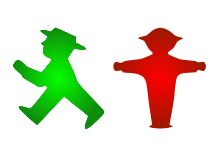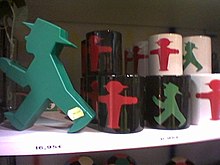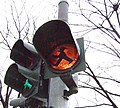Ampelmännchen

Template:Foreignchar (German: little traffic light man, pl. Ampelmännchen) is the symbolic person shown on traffic lights at pedestrian crossings in the former German Democratic Republic (GDR - East Germany). Prior to the German reunification in 1990, the two German states had different forms for the Ampelmännchen, with a generic human figure in West Germany, and a generally male figure wearing a hat in the east.
The Ampelmännchen is a beloved symbol in Eastern Germany,[1] "enjoy[ing] the privileged status of being one of the sole features of communist East Germany to have survived the end of the Iron Curtain with his popularity unscathed."[2] After the fall of the Berlin Wall, the Ampelmännchen acquired cult status and became a popular souvenir item in the tourism business.[1]
Concept and design

The first traffic lights at pedestrian crossings were erected in the 1950s, and many countries developed different designs (which were eventually standardized).[3] At that time, the traffic lights were equal for car, bicycles and pedestrians.[4] The East Berlin Ampelmännchen was created in 1961 by traffic psychologist Karl Peglau as a proposal for new traffic lights layout. Peglau criticised that the standard colours of the traffic lights (red, yellow, green) were not considerate of traffic participants who were unable to differentiate between colours (10 percent of the total population), and the traffic lights themselves were too small and too weak against luminous advertising and sunlight. Peglau's proposal to retain the three colours but to introduce intuitive shapes for each coloured light received strong support from many sides, but the high costs for restructure put off Peglau's plans of a colour-shape traffic light.[5]
Contrary to motor traffic, pedestrian traffic has no constrains for age or (mental) health, and has to account for children, elderly people and the mentally handicapped. Peglau therefore resorted to the realistic-concrete scheme of a little man that is comprehensible for everyone and appeals to archetypical shapes. The thick outstretched arms of the frontal-standing red man is associated with the function of a blocking barricade to signal "stop", while the side-facing green man with his wide-paced legs is associated with a dynamic arrow, signalling the permission to "go ahead". The yellow light was abandoned from pedestrian traffic lights because of generally unhurried pedestrian traffic.[5]
Peglau's secretary Anneliese Wegner drew the Ampelmännchen per Peglau's suggestions. The initial concept envisioned the Ampelmännchen to have fingers, but this idea was dropped for technical reasons of illumination. However, the man's "perky", "cheerful" and potentially "petit bourgeois" hat was retained to Peglau's surprise. The prototypes of the Ampelmännchen traffic lights were built at the VEB-Leuchtenbau Berlin.[5] Four decades later, Daniel Meuren of the West German Der Spiegel described the Ampelmännchen as uniting "beauty with efficiency, charm with utility, [and] sociability with fulfilment of duties".[6] The Ampelmännchen reminded others of a childlike figure with big head and short legs, or a religious leader.[7]
History in East Germany

The Ampelmännchen was officially introduced on 13 October 1961 in Berlin, at which time the media attention and public interest focused on the new traffic lights, not the symbols.[5] The first Ampelmännchen were produced as cheap decal pictures. Beginning in 1973, the Ampelmännchen traffic lights were produced at VEB Signaltechnik Wildenfels and privately-owned artisan shops.[8]
The Ampelmännchen proved so popular that parents and teachers initiated the symbol to become part of road safety education for children in the early 1980s.[5] The East German Ministry of the Interior had the idea to bring the two traffic light figures to life and turn them into advisors. Die Ampelmännchen were introduced with much media publicity. They appeared in strip cartoons, also in situations without traffic lights. The red Ampelmännchen appeared in dangerous moments, and the green Ampelmännchen was an advisor. Together with the Junge Welt publishing company, games with the Ampelmännchen were developed. Ampelmännchen stories were developed for radio broadcasts.[9] Partly-animated Ampelmännchen stories with the name Stiefelchen und Kompaßkalle were broadcast once a month as part of the East German children's bedtime television programme Sandmännchen, which had one of the highest viewing figures in East Germany.[10] The animated Ampelmännchen stories raised international interest, and the Czech festival for road safety education films awarded Stiefelchen und Kompaßkalle the Special Award by the Jury and the Main Prize for Overall Accomplishments in 1984.[10]
History after the German reunification


Following the German unification in 1990, there were attempts to standardise all traffic signs to the West German forms. East German street signs and traffic signs were dismantled and replaced because of differing fonts in the former two German countries.[11] The East German education programmes featuring the Ampelmännchen vanished. This lead to calls to save the East German Ampelmännchen as a part of the East German culture.[1][2] The first solidarity campaigns for the Ampelmännchen took place in Berlin in early 1995.
Markus Heckhausen, a graphic designer from the West German city of Tübingen and founder of Ampelmann GmbH in Berlin,[1] had first noticed the Ampelmännchen during his visits to East Berlin in the 1980s. When he was looking for new design possibilities in 1995, he had the idea to collect dismantled Ampelmännchen and build lamps. But he had difficulty finding old Ampelmännchen and eventually contacted the former VEB Signaltechnik (now Signaltechnik Roßberg GmbH) for remainders. The company was still producing Ampelmännchen and liked Heckhausen's marketing ideas. The public embraced Heckhausen's first six lamp models. Local newspapers and the yellow press published full-page articles, followed by articles in national newspapers and designer magazines. The successful German daily soap Gute Zeiten, schlechte Zeiten used the Ampelmännchen lamp in their coffeehouse set.[7] Designer Karl Peglau explained the public reaction in 1997:
"It is presumably their special, almost indescribable aura of human snugness and warmth, when humans are comfortably touched by this traffic symbol figure and find a piece of honest historical identification, giving the Ampelmännchen the right to represent a positive aspect of a failed social order."[12]
The Ampelmännchen became a kind of mascot for the East German nostalgia movement, known as Ostalgie.[2] The protests were successful, and the Ampelmännchen returned to pedestrian crossings, including all western districts of Berlin in 2005.[4] Some western German cities such as Saarbrücken[13] or Heidelberg[14] have since adopted the design for some intersection. Peter Becker, marshal of Saarbrücken, explained that lights of the East German Ampelmännchen have greater signal strength than West German traffic lights, and "we have made the experience that people react better to the East German Ampelmännchen than the West German ones."[13] In Heidelberg, however, a government department asked the city to stop the installation of more East German Ampelmännchen, citing standards in road traffic regulations.[14]

Heckhausen continued to incorporate the Ampelmännchen design into products and had an assortment of over forty Ampelmännchen souvenir products in 2004, reportedly earning 2 million euros yearly. In the meantime, Joachim Roßberg claimed to make 50,000 euros for merchandise a year. Heckhausen appealed to a Leipzig court in 2005 over the marketing rights, suing Roßberg for failing at making full use of his marketing rights; German legislature rules that if no use of marketing rights is made for five years, the rights can be cancelled. The court ruled in 2006 that Roßberg's right to use the Ampelmännchen as a marketing brand had largely lapsed and had passed back into the public domain. Roßberg only retained the right to use the symbol to market liqueur, and may no longer use the logo on beer and T-shirts. The court case was later seen by some as part of the cultural and political struggle between residents of the two parts of the reunified country, in which the underdog East generally loses.[2][1]
Berlin started to modernize its traffic lights from using regular light bulbs to LED technology in early 2006, which promised better visibility and lower maintenance costs.[15]
Variations
There are three Ampelmännchen variations in modern-day Germany – the old East German version, the old West German version, and a pan-German Ampelmännchen that was introduced in 1992. Each German state holds the rights for which version to use.[16] East Germans had changed the look of Ampelmännchen traffic lights as a joke since the early 1980s, but this turned into media-effective efforts to call attention to the vanishing East German Ampelmännchen in the 1990s.[17] The Ampelmännchen on several traffic lights in Erfurt were changed through manipulation of the template, showing Ampelmännchen carrying backpacks or cameras.[14] In 2004, Joachim Roßberg invented the female counterpart to the Ampelmännchen, the Ampelfrau, which was installed on some traffic lights in Zwickau[18] and Dresden.[19]
-
The Ampelfrau
-
Ampelmännchen with umbrella
-
Ampelmännchen with bicycle
-
Ampelmännchen as warning light
References
Notes
- ^ a b c d e "East German Loses Copyright Battle over Beloved Traffic Symbol". Deutsche Welle. 17 June 2006. Retrieved 2008-12-06.
- ^ a b c d "Ampelmännchen is Still Going Places". Deutsche Welle. 16 June 2005. Retrieved 2008-12-06.
- ^ Heckhausen, Markus (1997). "Die Entstehung der Lichtzeichenanlage". Das Buch vom Ampelmännchen. pp. 15–17.
- ^ a b Jacobs, Stefan (26 April 2005). "Ein Männchen sieht rot" (in German). Der Tagesspiegel. Retrieved 2009-02-06.
{{cite web}}: Italic or bold markup not allowed in:|publisher=(help) - ^ a b c d e Peglau, Karl (1997). "Das Ampelmännchen oder: Kleine östliche Verkehrsgeschichte". Das Buch vom Ampelmännchen. pp. 20–27.
- ^ Meuren, Daniel (26 September 2001). "Die rot-grüne Koalition" (in German). Der Spiegel. Retrieved 2009-02-06.
Das 40 Jahre alte Ampelmännchen sozialistischer Prägung verbindet Schönheit mit Effizienz, Charme mit Zweckmäßigkeit, Gemütlichkeit mit Pflichterfüllung.
{{cite web}}: Italic or bold markup not allowed in:|publisher=(help) - ^ a b Heckhausen, Markus (1997). "Ampelmännchen im zweiten Frühling". Das Buch vom Ampelmännchen. pp. 52–57.
- ^ Roßberg, Joachim (1997). "Vom VEB zur GmbH". Das Buch vom Ampelmännchen. pp. 42–44.
- ^ Vierjahn, Margarethe (1997). "Verkehrserziehung für Kinder". Das Buch vom Ampelmännchen. pp. 28–30.
- ^ a b Rochow, Friedrich (1997). "Stiefelchen und Kompaßkalle". Das Buch vom Ampelmännchen. pp. 32–41.
- ^ Gillen, Eckhart (1997). Das Buch vom Ampelmännchen. p. 48.
- ^ Peglau, Karl (1997). "Das Ampelmännchen oder: Kleine östliche Verkehrsgeschichte". Das Buch vom Ampelmännchen. p. 27.
Vermutlich liegt es an ihrem besonderen, einer Beschreibung kaum zugänglichen Fluidum von menschlicher Gemütlichkeit und Wärme, wenn sich Menschen von dieser Symbolfiguren der Straße angenehm berührt und angesprochen fühlen und darin ein Stück ehrlicher historischer Identifikation finden, was den Ampelmännchen das Recht zur Repräsentation der positiven Aspekte einer gescheiterten Gesellschaftsordnung gibt.
- ^ a b Bolzenius, Theodor (23 May 2006). "Polizisten flitzen mit Segways durch die Kirchenmeile" (in German). katholikentag.net. Retrieved 2008-12-11.
- ^ a b c "Deutschland wächst zusammen – Ampelmännchen und Grüner Pfeil". Politik und Unterricht (in German) (2/2000). 2000. Retrieved 2008-12-11.
{{cite journal}}: Cite has empty unknown parameter:|coauthors=(help) - ^ Lemmer, Christoph (8 May 2006). "Ampelmännchen privat". Der Tagesspiegel. Retrieved 2009-02-06.
{{cite web}}: Italic or bold markup not allowed in:|publisher=(help) - ^ "Heimliches Wappen der DDR" (in German) (2/1997). Der Spiegel. 6 January 1997: 92.
{{cite journal}}: Cite journal requires|journal=(help); Italic or bold markup not allowed in:|publisher=(help) - ^ König, Maria (1997). "Die Gallier aus Thüringen". Das Buch vom Ampelmännchen. pp. 46–47.
- ^ "Grünes Licht für Ampelfrau" (in German). Der Spiegel. 23 November 2004. Retrieved 2008-12-11.
{{cite web}}: Italic or bold markup not allowed in:|publisher=(help) - ^ "Markenrechte an Ampelfrau beschäftigen die Justiz" (in German). Berliner Morgenpost. 23 April 2007. Retrieved 2008-12-11.
{{cite web}}: Italic or bold markup not allowed in:|publisher=(help)
Bibliography
- Heckhausen, Markus, ed. (1997). Das Buch vom Ampelmännchen (in German). Eulenspiegel Verlag. ISBN 3-359-00910-X.
External links
- Ampelmann at ampelmann.de




